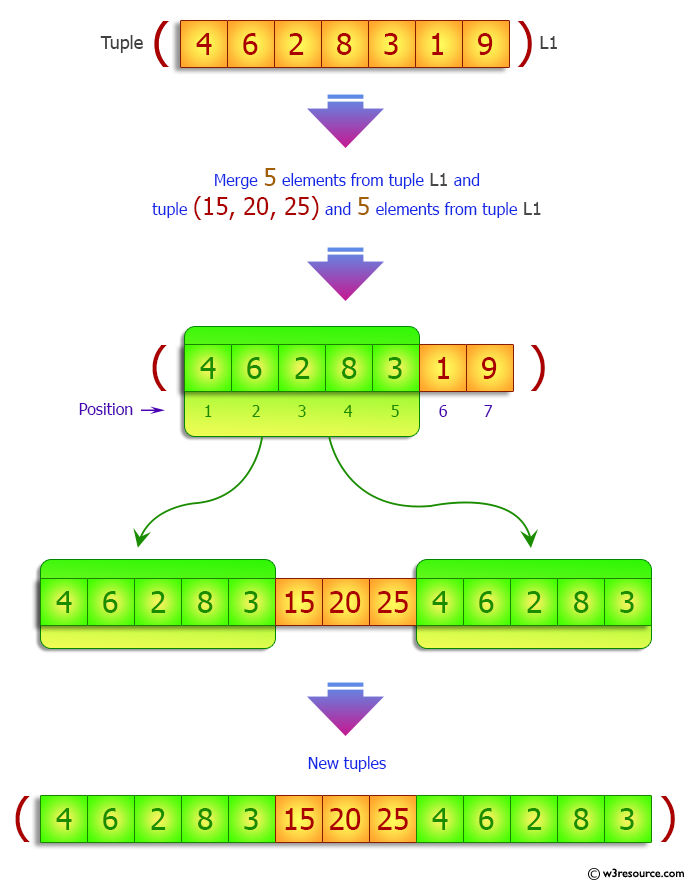

After that, we will concatenate the newly created tuples, excluding the element at index “i” as follows. The second tuple will contain elements from index “i+1” to last. The first slice will contain elements from index 0 to i-1 of the original tuple. To delete an element present at an index “i”, we will create two slices of the original tuple. If we need to delete the last element of a tuple, we will slice out the remaining elements as follows. To delete an element from the start of a tuple, we will create a new tuple using the rest of the elements as follows.
Tuple unpacking python 3 how to#
Updated tuple is: (1, 2, 3, 0, 4, 5, 6, 7, 8) How to modify a tuple by deleting an element MyTuple = (*left_tuple, value, *right_tuple) We can also use packing and unpacking to merge the newly created tuples as follows. MyTuple = left_tuple + (value,) + right_tuple Print("Value to be inserted at index 3:", value) Then we will concatenate the three tuples to insert the new element at index “i” as follows. After that, we will create a tuple with a single element which has to be inserted into the tuple at index i. The second tuple will contain elements from index “i” to last. The first tuple will contain elements from index 0 to i-1 of the original tuple. If we have to insert an element at index “i” of the tuple, we will slice the tuple and create two new tuples. To insert an element at a specific position in a tuple, we can use slicing. Updated tuple is: (5, 1, 2, 3, 4) How to insert an element at a specific position in a tuple Just like appending an element to the end of a tuple, we can append an element to the start of a tuple using packing and unpacking as follows. After that, we will create a new tuple including the new element as follows.

First, we will unpack the existing tuple using the * operator. myTuple = (1, 2, 3, 4)įor appending element to the tuple, we can also use packing and unpacking using the * operator.
Tuple unpacking python 3 series#
The Python interpreter confirms that the list_to_tuple_example variable contains a tuple: Convert a Dictionary to a TupleĪ Python dictionary is composed of a series of key-value pairs that are wrapped in curly braces.We can also append an element to the start of the tuple using the above method as follows. Use the type() function to display the list_to_tuple_example variable’s type. list_to_tuple_example = tuple(example_list) To convert example_list into a tuple, pass example_list as an argument of the tuple() method, and assign the result to a new variable. In Python, a list contains comma-separated items wrapped in square brackets. The following sections show you how to convert Python’s collection types into a tuple. Python collection types include lists, tuples, sets, and dictionaries. The tuple() function converts the four Python collection types into a tuple. The difference occurs because the first example includes a trailing comma, while the second example does not. The Python interpreter confirms that the day variable does not store a tuple, and instead stores a string: Now, store the same value in the day variable, but exclude the trailing comma. The Python interpreter confirms that day contains a tuple with a single value. Use the type() function to display the day variable’s type. For example, create the following tuple to store a single string. If you don’t include the comma, Python does not store the value as a tuple. To store a single value, or singleton in a tuple, you must include a comma when assigning the value to a variable. If you print example_tuple, the following is returned: print(example_tuple)Ĭreate a Tuple with a Single Value (Singleton) Use the built-in tuple() method to create a new tuple: example_tuple = tuple() You can exclude the parentheses when creating a tuple with multiple values: example_tuple = 1, 2, 3 Create a Python TupleĪ Python tuple can be created in the following ways:Ĭreate an empty tuple with an empty pair of parentheses: example_tuple = ()Ĭreate a tuple with multiple values that are separated with commas: example_tuple = (1, 2, 3) The section below covers the syntax for each way that you can create a Python tuple. However, there are a few syntax quirks to keep in mind when working with tuples in Python. The syntax to create a Python tuple is made up of your tuple values that are comma separated and enclosed in parentheses. You should have Python 3.0 installed on your machine to follow along with the examples in this guide.


 0 kommentar(er)
0 kommentar(er)
